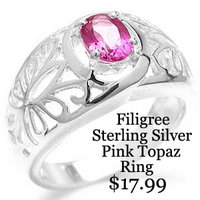Filigree Sterling Silver Jewelry History 3000 B.C. To 400 A.D.
 n. Filigree /filligree/: From the Latin ‘Filum’, meaning ‘Thread’, and ‘Granum’ meaning ‘Seed’. Filigree is the art of curling, twisting and plaiting fine pliable threads of precious metals, and uniting them at their points of contact by means of gold or Silver solder.
n. Filigree /filligree/: From the Latin ‘Filum’, meaning ‘Thread’, and ‘Granum’ meaning ‘Seed’. Filigree is the art of curling, twisting and plaiting fine pliable threads of precious metals, and uniting them at their points of contact by means of gold or Silver solder.Introduction
Perfected over millennia, incorporating the ancient techniques and styles of vanished civilizations, Filigree is without a doubt one of the oldest and most beautiful art forms known to man.
Unlike the mass of jewelry produced today Filigree jewelry is totally handcrafted, calling for hours of concentration on the part of its maker. The knowledge behind Filigree’s meticulous creation, passed down from generation to generation, remains a closely guarded secret kept in the hands of lapidary masters stretching from the islands of the Mediterranean sea to the shores of East India.
The Egyptians And Filigree
Filigree’s intricate lace-like trellises are entwined in mystery. For eons it was believed that Filigree had its roots planted in the classical Greek period 400 years before the birth of Christ. However, in the 1920s archeologists lifted the lid on two of the most significant finds this century, revealing that Filigree was in fact more than 5000 years old.
The first discovery was of a Filigree knife sheath dating from 2600 B.C., found in the royal tomb of the Mesopotamian Queen Pu-Abi. The second was the discovery of several gold and Silver rings with exquisitely formed Filigree shanks dating from 1350 B.C., found in the legendary tomb of the Egyptian pharaoh Tut-ankh-amun.
The Phoenicians And Filigree
Later discoveries, similar to the Egyptian and Mesopotamian Filigree but dating from 1000 B.C. were found in Phoenicia, present day Lebanon. Archeologists concluded that the seafaring Phoenicians had been influenced by the two cultures through widespread trade in gold and Silver.
The Phoenicians spread their skills throughout the Mediterranean; many settling in southern Italy integrating with the Etruscans, a civilization of the 7th century B.C. dedicated to the arts. The Etruscan artists fused traditional geometric designs with the Phoenician’s oriental influences of floral and figurative designs, refining Filigree to such an extraordinary degree that to this day their designs remain unsurpassed even by modern jewelers.
The Greeks And Filigree
In the eastern Mediterranean the Greeks had been using Filigree techniques since the time of the Trojan wars and were quick to integrate the refined Etruscan style into their jewelry. Necklaces were decorated with Filigree flowers and tassels, hoop earrings with Filigree disks and rosettes. With the conquests of Alexander the Great Greece attained a wealth of gold and Silver booty plundered from the Phoenicians, Egyptians, Persians and Indians. And from 323 B.C., during the Hellenistic period, Greek Filigree became prolific from southern Europe to India influencing craftsmen throughout the massive empire.
The Romans And Filigree
By 133 B.C. Rome had absorbed the entirety of the Greek Empire and its economic wealth. And with the rise of the Roman Empire a new phase of jewelry design was ushered in with the use of colored gemstones. Roman craftsmen applied gold and Silver as settings for emeralds, sapphires, rubies, peridots, garnets and pearls. However, Roman jewelers, in order to emphasize the gems rather than their settings preferred plainer geometric shapes to the detailed styles of classical Greek jewelry, and techniques like Filigree and granulation fell out of fashion.
The Byzantines And Filigree
By the 4th Century A.D. the Roman Empire in Europe had fallen into the hands of the barbarian tribes of the Goths and Vandals, the ‘Dark Ages’ ensued and Rome’s art forms were lost. However, the East of the Roman Empire known as the Byzantine Empire became a repository of classical learning, preserving the artistic heritage of the Greek and Roman artisans. The Byzantine Empire was Christian, and rich, this is reflected in the opulent gold and Silver icons, book covers of gospels and panels of reliquaries crafted in the monasteries. The large surfaces of these objects were encrusted with precious stones cut into cabochons and decorated with fine Filigree, granulation, engravings, and enameling techniques known as cloisonné.
Copyright © SilverShake Corporation. All Rights Reserved.
Written for SilverShake, an online retailer of filigree jewelry and sterling silver jewelry at wholesale prices. Purchase today and get silver jewelry worth up to $60...Free!


